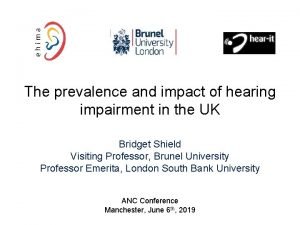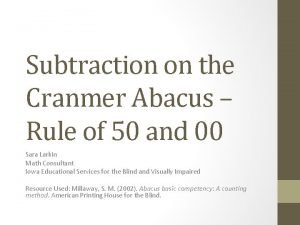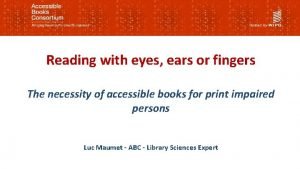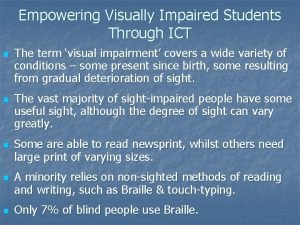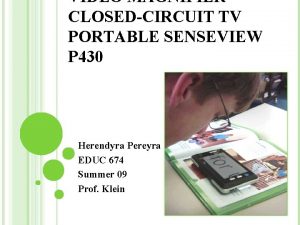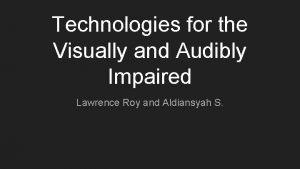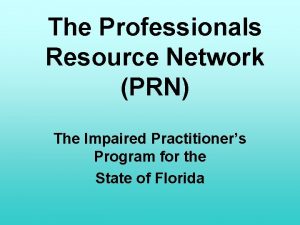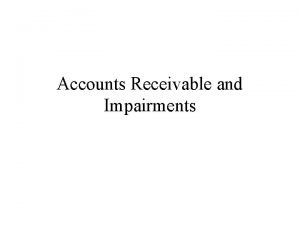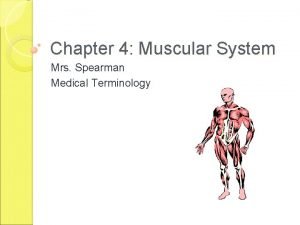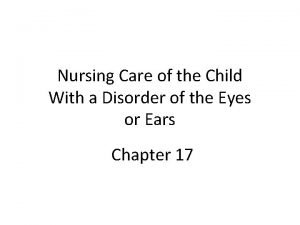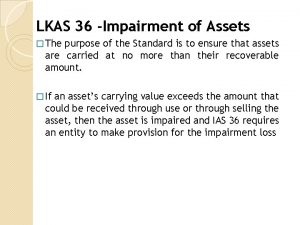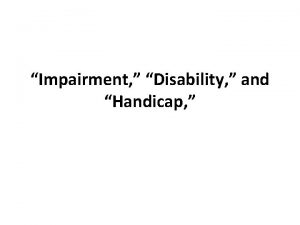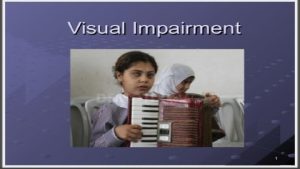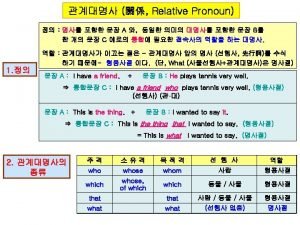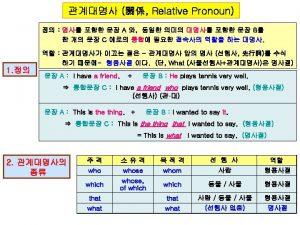Hearing Impairment An individual whose hearing is impaired
























- Slides: 24

Hearing Impairment

• An individual whose hearing is impaired so that he cannot function normally in the classroom without help is said to have a hearing impairment. • He may be able to hear sounds, but they may be unclear or he may only be able to hear sounds in certain ranges. • The development of language, communication and understanding of the spoken work will be delayed and so will have an impact on his access to the wider world and education. • Detection of a hearing impairment at an early stage is of vital importance as behaviour and social/emotional development may be affected too

• There are three types of hearing loss: • Sensorineural • Conductive • Mixed (1 + 2)

• Sensorineural • This is where the cause of the deafness is located in the cochlea or the auditory nerve. It can either be unilateral (one sided) or bilateral (affecting both ears). It is usually permanent.

Causes • • • Genetic/unknown/family history of deafness Maternal rubella Certain drugs, especially during pregnancy Severe jaundice at birth Prematurity Lack of oxygen at birth Brain damage at birth/brain injury later in life Some chromosomal disorders Some infections especially – measles, meningitis, mumps, viral infections

• Conductive • In this type of impairment sound waves are unable to pass through the eardrum, or the eardrum is prevented from vibrating through to the middle ear. Conductive hearing impairment is usually temporary and often fluctuating.

Causes • Blockage of the outer ear, external canal or middle ear by wax or foreign bodies such as peanuts, beads, etc • Swollen adenoids at the back of the nose, often following recurrent coughs and colds • Middle ear infections – otitis media. Infections enter via eustachian tube • Otitis media with effusion or ‘glue ear’. After an infection of the middle ear, or as a result of an allergy, fluid remains in the middle ear and becomes thick, like glue. As a result of this, the sound waves are prevented from travelling along the ear and the vibration of the eardrum

• There may be children in mainstream classes who have an undetected hearing loss. • Young children may experience fluctuating hearing losses due to recurring ear infections. • There are many observable warning signs that a child may be experiencing difficulty in hearing. • The following are possible warning signs of an undetected hearing loss but are not exclusive to hearing loss and may have other underlying causes. • Observation of the signs and discussion with other professionals will determine the cause

The child may: Daydream a lot Not obey instructions Ask questions that have just been explained Perform poorly in group discussions Strain to listen Pay close attention to the speaker’s face Often say ‘eh’ or ‘what’ Experience difficulty in locating or listening to a speaker in large areas or noisy settings • Smile or nod and then do the wrong thing • Often ask for repetition • Speak out loud • •

Conductive Hearing Loss • Conductive hearing loss occurs in either the outer or middle ear. • It may be the result of glue ear, malformation of the middle ear bones, or a perforated eardrum. • It is usually treatable by either medication or surgery. • Conductive hearing loss may be mild, moderate, or fluctuating. • Amplifying sounds and paying close attention to appropriate position and seating in a classroom can overcome many potential difficulties.

Glue Ear • By far the most common condition associated with conductive hearing loss in children is glue ear. • This is often caused by a ‘glue like’ fluid, which collects in the middle ear (behind the eardrum) when a child has a heavy cold or catarrh. • Sounds can then not be conducted to the inner ear and this problem is often called a conductive hearing loss.

• This hearing loss can fluctuate, changing from day to day. However, it can cause a habit of not listening very well and this might lead to frustrations and difficulties both for the child and parent/teacher. • Listening with a conductive hearing loss is like listening to the television with the sound turned too low, or trying to hold a conversation in a noisy room, or listening under water

• Treatment can involve medication and, sometimes, surgery. • In many cases the condition clears up by itself over time. • If the condition is not resolved, the surgeon will draw out any fluid from the middle ear cavity by making a tiny incision in the eardrum. • This operation is called a myringotomy. • A ventilation tube (grommet) may be inserted. The adenoids may also be removed. • Occasionally conductive hearing loss is caused by congenital malformation of the ear.

Sensorineural hearing loss • Sensorineural deafness is permanent and occurs when there is damage to the inner ear. • Conditions affecting the inner ear often have serious implications for hearing and can be caused by genetic factors, illness or accident. • It can be mild, moderate, severe or profound

Mixed Hearing Loss • A mixed hearing loss involves both the middle and inner ear. • It is important to realise that children with sensorineural hearing loss are as prone as anyone else to temporary middle ear disorders causing an additional conductive hearing loss. • It is therefore essential that the condition is recognised and dealt with as soon as possible.

Moderate Hearing Loss • Pupils with a moderate hearing loss will have difficulty hearing sounds within the speech range. They will need sounds to be amplified. • These pupils usually wear hearing aids and may use a radio aid in the classroom. • The hearing loss may be permanent (sensorineural) or temporary (conductive) - although some temporary losses of this type persist for a long time.

• Spoken language is likely to be good although there may be gaps in vocabulary, spellings, and general knowledge. • It can be easy to assume there are few or no problems. • A high level of concentration is required throughout the day and the pupil may become tired.

Some difficulties you may notice: • similar words are confused • words endings may be missing, particularly plurals • unstressed words in speech (especially prepositions eg ‘in’, ‘on’, ‘up’) may be missed, or misinterpreted. • verb tenses may be incorrect • both peers and adults may be misunderstood • swift understanding may depend on the ability to see the speaker’s face clearly

What are grommetts • What are grommets? • They are very small plastic tubes, which have a hole in the middle which allows the drainage of the ear. They are extremely small about the size of a 1 cent piece. • • Why are they needed? • Behind each eardrum is a small space called the middle ear. Normally this space is filled with air, which is replaced automatically when a child swallows. Sometimes this does not happen. Fluid has replaced the air in the middle ear causing a hearing problem.

• Where are the grommets put? • One grommet is put into each eardrum. A very small cut (myringotomy) is made in the eardrum and any fluid is removed before the grommet is put in. • What are the benefits? • Air will get back into the middle ear and the hearing should improve immediately. • Will the grommets have to be removed? • Most grommets are specially designed to come out on their own. As the eardrum heals, the grommet is squeezed out. Sometimes they fall out of the ear during sleep and can be found in the bed. They work their way out with normal wax.

• What will happen if they are not used? • The child may take a very long time to get rid of the fluid. The fluid may get thicker in the ears. The child’s hearing may stay poor and this could affect language development and educational progress. • Will grommets be needed again? • Usually, grommets are only needed once. However, if the fluid returns, more grommets may have to be inserted.

How to help the student with a hearing loss while in your care • Speak clearly – use a strong voice, speak naturally and at a normal rate. Use whole sentences and not single words. • Reiterate what the other pupils are saying – at a distance, the pupil with a hearing loss may not hear the comments, questions or answers • Get close – when talking, try to be as close as possible to the pupil. The pupil will need to see your face and lips • Don’t hide your mouth – face the pupil when you are talking and try not to cover your face with your hands

• Allow the pupil to see your face and expression • Make sure of the pupil’s attention before starting – a pupil with a hearing loss may only look up and concentrate when your voice gets loud enough, and therefore may have missed the introduction • Give clues – clue in the pupil so that s/he knows what you are going to talk about. • Attract attention – make sure you have got the pupil’s attention before you begin to talk, or the first part of the conversation will be lost • Include the pupil in group discussions and story time • Keep noise levels to a minimum • Try to make sure that only one person talks at a time • Make constant references to the point of conversation • Use visual as well as verbal referrals to the topic discussed

 Visual impairment ppt
Visual impairment ppt Hearing impairment meaning
Hearing impairment meaning Hearing impairment disability
Hearing impairment disability Objectives of input output management
Objectives of input output management Cranmer abacus
Cranmer abacus Impaired eyes and ears
Impaired eyes and ears Nursing diagnosis for poor appetite
Nursing diagnosis for poor appetite Impaired mentation
Impaired mentation She walks in beauty summary
She walks in beauty summary Impaired receivables
Impaired receivables Ict for visually impaired students
Ict for visually impaired students Impaired digestion
Impaired digestion Impaired urinary elimination
Impaired urinary elimination Story boxes ideas
Story boxes ideas Ob db
Ob db Senseview
Senseview Virginia department for the blind and vision impaired
Virginia department for the blind and vision impaired Impaired gas exchange subjective data
Impaired gas exchange subjective data Visually and audibly
Visually and audibly Professionals resource network
Professionals resource network Impairment of accounts receivable
Impairment of accounts receivable Impairment loss on trade receivables
Impairment loss on trade receivables Chapter 4 the muscular system
Chapter 4 the muscular system Nursing care plan for conjunctivitis slideshare
Nursing care plan for conjunctivitis slideshare Lkas 36 impairment of assets
Lkas 36 impairment of assets


